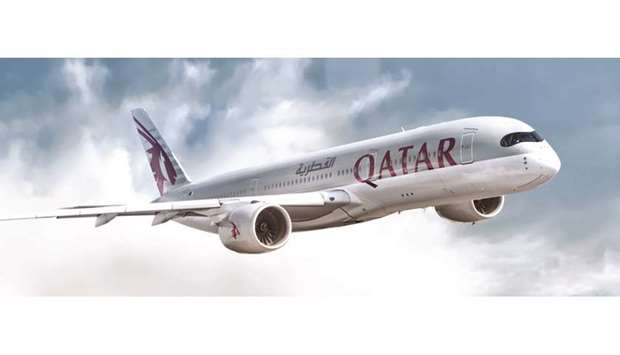Qatar Airways looks forward to receiving its first Airbus A350-1000 this year, said the national airline, which became the global launch customer for the technologically superior Airbus A350 in 2015.
In total, the national carrier expects to receive an additional 29 Airbus A350-900s and 37 Airbus A350-1000s over the next five years.
In the two years since its launch, the A350 has become “extremely popular” with passengers who “appreciate the reduced symptoms of post-flight fatigue” after travelling on this state-of-the-art aircraft, as well as the “unprecedented levels of on-board comfort”, Qatar Airways said in its latest annual report.
From an operational perspective the aircraft has been a “highly successful addition” to the fleet due to its “fuel efficiency and lower maintenance” requirements.
Due to the delay in delivery of its Airbus A350, the Qatar Airways fleet, as of March 31, includes two Airbus A350-900 leased from LATAM. Two further LATAM Airbus A350 aircraft will join the fleet over the course of 2017, helping to alleviate the shortage, which has hampered Qatar Airways’ ambitious expansion plans.
Qatar Airways said it “has also been frustrated by the issues it has experienced” with the delivery of its order of Airbus A320neos.
The airline was scheduled to be the launch customer of this aircraft type but declined the first four deliveries due to unsatisfactory engine performance. Qatar Airways and Airbus have now reached an agreement, whereby the remaining A320neos on order will be converted to A321neos.
In October last year, Qatar Airways announced an order for 30 Boeing 787-9 Dreamliners and 10 Boeing 777-300ERs, valued at $11.7bn. To help mitigate against the ongoing aircraft delivery delays, the airline also signed a letter of intent for up to 60 Boeing 737 MAX 8s, valued at $6.9bn.
With this new order, Qatar Airways increased its firm order backlog of Boeing wide body airplanes from 64 to 104, including 60 Boeing 777Xs.
The national carrier operates a mixed fleet of Airbus and Boeing aircraft including both wide and narrow body types, giving the airline the flexibility to serve its growing network of regional and global destinations. With one of the youngest fleets in commercial aviation – the average aircraft age is approximately five years – Qatar Airways offers passengers one of the most technologically advanced on-board experiences in the skies.
As of March 31, the 196-strong fleet included 16 of the new generation Airbus A350-900 as well as 30 Boeing 787 Dreamliners.
‘Committed to productive talks with EU’
Qatar Airways is committed to productive talks with the European Union (EU) for a mutually-beneficial and comprehensive air transport agreement for enhanced market access for the airlines of both parties, said airline Group CEO Akbar al-Baker.
In September last year, Qatar and the EU started negotiations for such an agreement.
“The negotiations provide a unique opportunity to strengthen bilateral relations between the State of Qatar and the EU. Qatar Airways welcomes more competition from European airlines that would be able to benefit from a liberalised and open market,” al-Baker said in Qatar Airways’ 2017 annual report.
Greater and more flexible market access is good for Qatar Airways and will bring great benefits to consumers in terms of price, connectivity and travel options, he said.
Greater liberalisation in the airline industry and government deregulation have made air travel accessible for millions of people in mature and emerging markets alike and the trend may continue in the coming years.

The technologically superior Airbus A350, of which Qatar Airways became the global launch customer in 2015.

